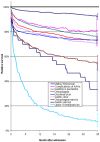Prognosis following upper gastrointestinal bleeding
- PMID: 23251344
- PMCID: PMC3520969
- DOI: 10.1371/journal.pone.0049507
Prognosis following upper gastrointestinal bleeding
Abstract
Background: Upper gastrointestinal (GI) bleeding is one of the most common, high risk emergency disorders in the western world. Almost nothing has been reported on longer term prognosis following upper GI bleeding. The aim of this study was to establish mortality up to three years following hospital admission with upper GI bleeding and its relationship with aetiology, co-morbidities and socio-demographic factors.
Methods: Systematic record linkage of hospital inpatient and mortality data for 14 212 people in Wales, UK, hospitalised with upper GI bleeding between 1999 and 2004 with three year follow-up to 2007. The main outcome measures were mortality rates, standardised mortality ratios (SMRs) and relative survival.
Results: Mortality at three years was 36.7% overall, based on 5215 fatalities. It was highest for upper GI malignancy (95% died within three years) and varices (52%). Compared with the general population, mortality was increased 27-fold during the first month after admission. It fell to 4.3 by month four, but remained significantly elevated during every month throughout the three years following admission. The most important independent prognostic predictors of mortality at three years were older age (mortality increased 53 fold for people aged 85 years and over compared with those under 40 years); oesophageal and gastric/duodenal malignancy (48 and 32 respectively) and gastric varices aetiologies (2.8) when compared with other bleeds; non-upper GI malignancy, liver disease and renal failure co-morbidities (15, 7.9 and 3.9); social deprivation (29% increase for quintile V vs I); incident bleeds as an inpatient (31% vs admitted with bleeding) and male patients (25% vs female).
Conclusion: Our study shows a high late as well as early mortality for upper GI bleeding, with very poor longer term prognosis following bleeding due to malignancies and varices. Aetiologies with the worst prognosis were often associated with high levels of social deprivation.
Conflict of interest statement
Figures


References
-
- Palmer KR (2003) Haematemesis and melaena. Medicine 31: 19–24.
-
- Hearnshaw SA, Logan RF, Lowe D, Travis SP, Murphy MF, et al. (2011) Acute upper gastrointestinal bleeding in the UK: patient characteristics, diagnoses and outcomes in the 2007 UK audit. Gut 60: 1327–1335. - PubMed
-
- Vreeburg EM, Snel P, de Bruijne JW, Bartlesman JF, et al. (1997) Acute upper gastrointestinal bleeding in the Amsterdam area: incidence, diagnosis, and clinical outcome. Am J Gastroenterol 92: 236–243. - PubMed
Publication types
MeSH terms
LinkOut - more resources
Full Text Sources
Medical

